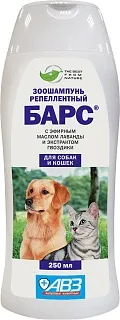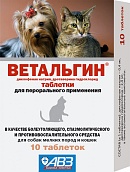BARS zoo shampoo repellent for dogs and cats
Product benefits:
- Natural product which can be used in the youngest puppies and kittens, pregnant, lactating and weakened animals.
- A highly effective product for fast killing of sucking lice, lice, fleas and ticks parasitizing animal.
- Single use saves an animal from sucking lice, lice, fleas and ticks.
- Hair gloss is acquired, as well as skin and hair root metabolic processes are improved.
Chemical composition and pharmacological properties
Shampoo contains essential oils of lavender and costus, extracts of clove and pelargonium (as active ingredients), as well as excipients (sodium lauryl ether sulphate, glycerol, allantoin, cocamidopropyl betaine, soya oil fatty acid diethanolamides, sorbitol, sodium chloride, citric acid, methylisothiasolinone, methylchloroisothiasolinone and distilled water).Appearance: clear colourless or light-yellow gel liquid. It can be mixed with water in all proportions.
Essential oils of lavender and costus, extracts of clove and pelargonium (components of the drug) have repellent effect.
Glycerol and allantoin with moisturizing, softening and anti-inflammatory properties have regulating effect on natural skin water balance, as well as remove dryness and exfoliation. Activating metabolic processes in hair bulbs, these components provide recovery of epidermal protective functions, improve hair structure, easy up combing, prevent hair entangling and remove dandruff.
Indications
Use as a washing and protective agent against ectoparasites (fleas, sucking lice, lice and ixodic ticks) in adult dogs and cats, as well as in puppies and kittens.Contraindications
Increased individual sensitivity to the drug components.Dosage and administration
Before administration freely moisturize animal pelage and skin with warm water, then apply shampoo (2-3 ml per 1 kg of body weight) equally distributing it along the body surface and gently rubbing until foam appears. Wash shampoo away with warm water in 2-3 minutes and dry hair. Long-haired animals need combing.
In severe cases repeat the procedure.
Reprocessing: according to indications.
Adverse events
Adverse events and complications are not observed in case of administration as per package insert.Storage
Store in closed original package. Protect from light. Store separately from food and animal feeding at 0-25°С.Pharmaceutical form
250 ml polymeric bottle. Outer package - carton.
The information provided in this catalog is for reference only. There may be some changes in the characteristics, packaging and packaging of products.
AVZ reserves the right to make such changes without notice. You can get full information about the updated products from your personal manager or your nearest AVZ dealer.
All drugs for veterinary use from this catalog may be contraindicated and when using it is necessary to familiarize yourself with the Instructions for Use.














